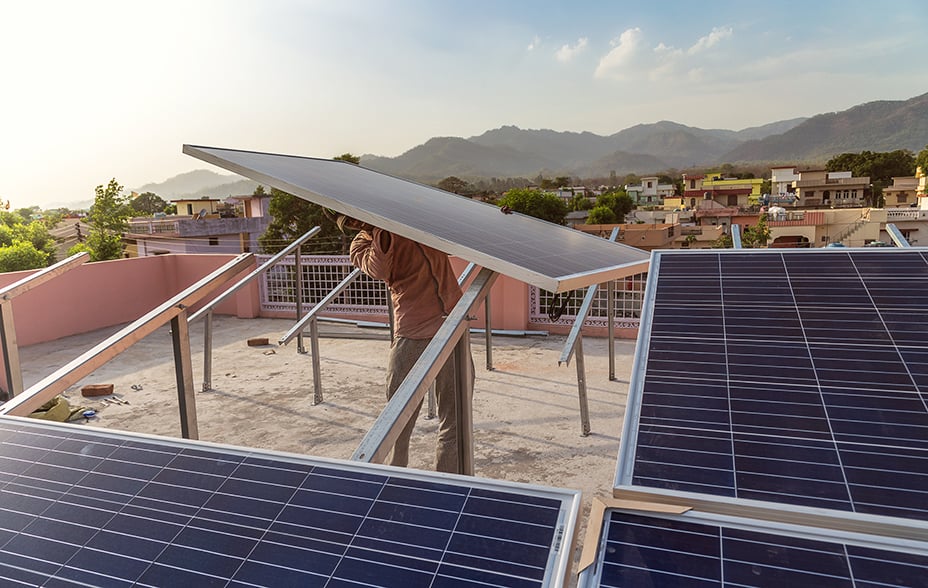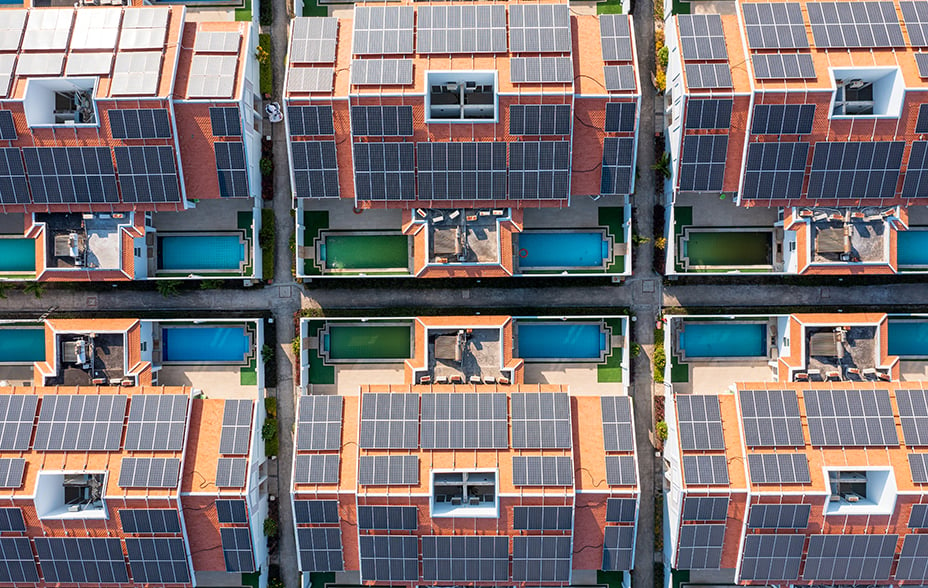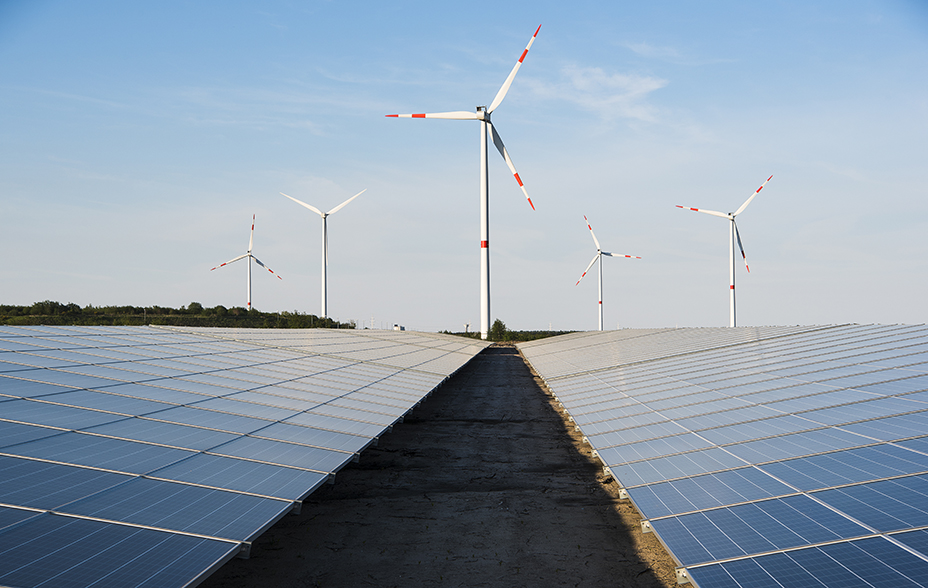
“When things are getting better, we often don’t hear about them. This gives us a systematically too-negative impression of the world around us, which is very stressful.”
Hans Rosling was largely talking about global living standards when he made that observation in his book Factfulness, but news about climate change is no different. The headlines which inform the public, and by extension most participants in financial markets, leave us stewing in a marinade of short-term environmental disasters that foreshadow long-term existential uncertainty. Academics alert us to the harm we are doing, and governments make grandiose guarantees, but despite the international targets and corporate promises, the trend line of global temperatures ploughs relentlessly on, up and to the right.
There are two ways to interpret this. The first is to say that this genuinely is a doomed enterprise. Despite the action supposedly taken, climate change represents a truly intractable problem. The sweeping arc of history is too inert for us to make a difference, and we must reinvent our entire mode of life or learn to survive the consequences.
Alternatively, one could view the mounting commitments as a build-up of pressure – pressure that will suddenly be released as a dramatic inflection of progress. The wheels are spinning, but until the rubber hits the road, we won’t be going anywhere. When it does, we will.
I’m in the latter camp. There’s no room for complacency or naïveté when the stakes are so high, but the situation presented by the media often doesn’t marry up with the long-term trajectories of the technologies that can offer us ecological salvation. Abe Lincoln once said that if he had six hours to cut down a tree, he’d spend the first four sharpening his axe. We’ve been honing renewable technologies for the best part of 30 years, but their rollout has only just begun. Here are four reasons to be optimistic about climate change:
Green energy is cheap energy
No-one’s views on climate change were formed instantaneously. We learn more as the years go by and build up an understanding of the problem – and its potential solutions – over time. But this is a space where things move quickly. In the solar energy market, a financial or technological aeon for the rest of us can pass in the space of a few months. In 2009, the average cost of utility-scale solar energy was about $360/MWh. By 2015 it was down to around $64/MWh. Last year, Saudi Arabia inaugurated a solar facility at just $10/MWh.
In the minds of most, the terms ‘renewable’ and ‘cost-effective’ mix like oil and vinegar. People know what cheap energy looks like, they know what green energy looks like, and they have always entertained a little-questioned assumption that never the twain would meet. Then, surreptitiously and under the cover of pandemic headlines, they did. In 2021, an understated press release from the International Renewable Energy Agency informed the world that 62 per cent of new renewable energy projects from the previous year were cheaper than the cheapest new fossil fuel option. Even in India, where coal energy prices have historically been rock-bottom, newly built solar energy managed to undercut the price of electricity from coal plants already in operation.
This makes a huge difference. Back when renewables invariably required lavish subsidies, each potential developer had to find a government willing to bankroll them with taxpayer money. Underfunded bureaucracies would run excruciatingly slow auction processes, and fierce competition for the limited subsidy funding would invariably push down returns to the brink of commercial viability.
Now, with each passing year, subsidies are being phased out – not because governments have got cold feet, but because subsidies, along with their accompanying bureaucracy, simply aren’t necessary. As the market price of energy soars – even before carbon credits are phased in – and as the cost of producing renewable energy continues to plummet, the yawning spread between the two represents an unprecedented financial opportunity for companies able to offer cheap, local, decentralised green energy. The sun need not be extracted from the depths of the North Sea nor passed through a global logistics network in turmoil; the wind need not be purchased from tyrants. Now that supply chains are spluttering into gear and projects are being built with increasing scale and experience, renewables look more attractive by the month.
All that remains is a cultural shift. We are still obsessed with the ‘cost’ of the transition, and not with how much money could be saved in the long run by switching to deflationary renewables. As Mark Twain was supposed to have said,
“it ain’t what you don’t know that gets you in trouble, it’s what you know for sure that just ain’t so”.

Build at scale, and they will come
Given the dramatic cost reductions already seen in the renewables market, it’s tempting to think that the best days of cost savings are behind us. When it comes to wind power, the opposite may be true. As the market has developed, there has always been an incentive to build bigger turbines – a 10MW model will deliver twice as much revenue as its 5MW counterpart, but without a proportional increase in raw materials, installation costs, or maintenance expenses.
Yet while the burgeoning size of turbines has brought impressive reductions in costs, it means that few turbine models have ever been manufactured at scale. It can take years to design a turbine, test it, source the components, and forge a robust supply chain. So long, in fact, that by the time a turbine is commercially viable, a bigger and better model has often been designed, and the supply chains must be reconfigured and rebuilt with new components.
Unlike the solar panel manufacturers who can make their products by the tens of thousands, buying components in bulk and spreading development costs, turbine manufacturers have had to absorb high research and development costs without ever getting to mass-produce a single model at a meaningful scale. That may be about to change. Onshore turbines have now reached such a size that transporting them would be impossible if they got any larger: a slight bend in the road or pesky overpass would bring the vehicles carrying blades and towers to a standstill. With a natural limit reached, wind turbine manufacturers will finally be able to produce much greater volumes, and the economics of the 50,000th 8MW model produced are sure to look much more attractive than those of the 500th 2MW turbine.

No technology is an island
Carbon emissions are ubiquitous in the global economy, and the sheer range of new technologies needed to reach net zero can at times be depressing. But few realise the extent to which a few fundamental technologies at the core of the economy can trigger a cascade of solutions. We could pull carbon out of the atmosphere at scale today, but we don’t because the green energy needed is too expensive. We could make green steel the norm by using electric arc furnaces powered by renewables instead of blast furnaces – but again, we don’t, because the green energy cost has historically been prohibitive.
More immediately, we could electrolyse water, splitting it into oxygen and green hydrogen, which we could then use to help decarbonise everything from steelmaking and shipping to heating and heavy industry. The same problem haunts us: while the cost of electrolysers is in freefall as we switch from bespoke, hand-wound units to mass-produced modules, the cost of the green power needed for electrolysis can be as much as 75 per cent of the final cost of the hydrogen. Yet on our current trajectory, green hydrogen may soon be cheap and abundant, ready to burn in natural gas plants, power bus fleets, heat homes, and act as a store of energy for when the sun isn’t shining and the winds lie still.
The internet is just one technology, but its development has transformed the entire economy. Many industries owe it their very existence. The same could be said for semiconductors, fossil fuels, the telephone, railways… even, once upon a time, the humble stirrup. Increasingly affordable green electricity is not an isolated breakthrough, but one with innumerable corollaries.

The east is green
I’ve presented the energy transition here not as a steady linear shift, but as a build-up of pressure that is suddenly released when renewables reach the point of commercial viability. In China, we may be witnessing just such a release.
In November 2020, the Global Wind Energy Council released a paper estimating that over the course of that year, 71GW of new wind energy capacity would be installed worldwide; a record year and a job well done, all things considered. A few months later, China announced that it alone had installed a jaw-dropping 72GW of new wind capacity, significantly more than the rest of the world combined. Most of this was driven by a quantum leap in the level of onshore wind capacity – which many claimed would be a one-off fluke. The following year, however, it was the turn of China’s offshore market to deliver numbers so staggering that the journalists reporting them had to preface their articles by asking their readers to ensure they were sitting down. In 2021, China installed more offshore wind capacity than the rest of the world installed cumulatively over the last five years.
The country now has over three times more hydropower capacity than the next biggest producer, Brazil. It hosts eight of the world’s 10 biggest solar panel producers, and while covid-induced supply chain issues have hammered the western wind turbine manufacturers, their Chinese peers have unblinkingly posted record profits. Few had heard of names like Goldwind or Ming Yang a few years ago. Now they are fast approaching the size of the European champions.
The idea that geopolitical power will increasingly emanate from China in the coming decades is well established – but electrical power and its associated trappings? Less so. The media presents China as a laggard on climate change, chastising it for the so-called gap between rhetoric and reality. Critics note that the country is the world’s biggest emitter, and those who have visited Beijing in the summer will know the stifling smog that lies stagnant in its crowded hutongs. Nevertheless, the country’s trajectory on climate change is becoming crisper with each market update: the emerging picture is one of China not only embarrassing its critics by reducing its emissions much faster than anyone expects but enriching itself by selling surplus panels and turbines to a sluggish, bungling west.
Risk factors
The views expressed in this communication are those of Calum Holt should not be considered as advice or a recommendation to buy, sell or hold a particular investment. They reflect personal opinion and should not be taken as statements of fact nor should any reliance be placed on them when making investment decisions.
This communication was produced and approved in April 2022 and has not been updated subsequently. It represents views held at the time of writing and may not reflect current thinking.
Stock Examples
Any stock examples and images used in this communication are not intended to represent recommendations to buy or sell, neither is it implied that they will prove profitable in the future. It is not known whether they will feature in any future portfolio produced by us. Any individual examples will represent only a small part of the overall portfolio and are inserted purely to help illustrate our investment style.
This communication contains information on investments which does not constitute independent research. Accordingly, it is not subject to the protections afforded to independent research, but is classified as advertising under Art 68 of the Financial Services Act (‘FinSA’) and Baillie Gifford and its staff may have dealt in the investments concerned.
All information is sourced from Baillie Gifford & Co and is current unless otherwise stated.
The images used in this communication are for illustrative purposes only.
Important information
Baillie Gifford & Co and Baillie Gifford & Co Limited are authorised and regulated by the Financial Conduct Authority (FCA). Baillie Gifford & Co Limited is an Authorised Corporate Director of OEICs.
Baillie Gifford Overseas Limited provides investment management and advisory services to non-UK Professional/Institutional clients only. Baillie Gifford Overseas Limited is wholly owned by Baillie Gifford & Co. Baillie Gifford & Co and Baillie Gifford Overseas Limited are authorised and regulated by the FCA in the UK.
Persons resident or domiciled outside the UK should consult with their professional advisers as to whether they require any governmental or other consents in order to enable them to invest, and with their tax advisers for advice relevant to their own particular circumstances.
Financial intermediaries
This communication is suitable for use of financial intermediaries. Financial intermediaries are solely responsible for any further distribution and Baillie Gifford takes no responsibility for the reliance on this document by any other person who did not receive this document directly from Baillie Gifford.
Europe
Baillie Gifford Investment Management (Europe) Limited provides investment management and advisory services to European (excluding UK) clients. It was incorporated in Ireland in May 2018. Baillie Gifford Investment Management (Europe) Limited is authorised by the Central Bank of Ireland as an AIFM under the AIFM Regulations and as a UCITS management company under the UCITS Regulation. Baillie Gifford Investment Management (Europe) Limited is also authorised in accordance with Regulation 7 of the AIFM Regulations, to provide management of portfolios of investments, including Individual Portfolio Management (‘IPM’) and Non-Core Services. Baillie Gifford Investment Management (Europe) Limited has been appointed as UCITS management company to the following UCITS umbrella company; Baillie Gifford Worldwide Funds plc. Through passporting it has established Baillie Gifford Investment Management (Europe) Limited (Frankfurt Branch) to market its investment management and advisory services and distribute Baillie Gifford Worldwide Funds plc in Germany. Similarly, it has established Baillie Gifford Investment Management (Europe) Limited (Amsterdam Branch) to market its investment management and advisory services and distribute Baillie Gifford Worldwide Funds plc in The Netherlands. Baillie Gifford Investment Management (Europe) Limited also has a representative office in Zurich, Switzerland pursuant to Art. 58 of the Federal Act on Financial Institutions (‘FinIA’). It does not constitute a branch and therefore does not have authority to commit Baillie Gifford Investment Management (Europe) Limited. The firm is currently awaiting authorisation by the Swiss Financial Market Supervisory Authority (FINMA) to maintain this representative office of a foreign asset manager of collective assets in Switzerland pursuant to the applicable transitional provisions of FinIA. Baillie Gifford Investment Management (Europe) Limited is a wholly owned subsidiary of Baillie Gifford Overseas Limited, which is wholly owned by Baillie Gifford & Co. Baillie Gifford Overseas Limited and Baillie Gifford & Co are authorised and regulated in the UK by the Financial Conduct Authority.
China
Baillie Gifford Investment Management (Shanghai) Limited 柏基投资管理(上海)有限公司(‘BGIMS’) is wholly owned by Baillie Gifford Overseas Limited and may provide investment research to the Baillie Gifford Group pursuant to applicable laws. BGIMS is incorporated in Shanghai in the People’s Republic of China (‘PRC’) as a wholly foreign-owned limited liability company with a unified social credit code of 91310000MA1FL6KQ30. BGIMS is a registered Private Fund Manager with the Asset Management Association of China (‘AMAC’) and manages private security investment fund in the PRC, with a registration code of P1071226.
Baillie Gifford Overseas Investment Fund Management (Shanghai) Limited柏基海外投资基金管理(上海)有限公司(‘BGQS’) is a wholly owned subsidiary of BGIMS incorporated in Shanghai as a limited liability company with its unified social credit code of 91310000MA1FL7JFXQ. BGQS is a registered Private Fund Manager with AMAC with a registration code of P1071708. BGQS has been approved by Shanghai Municipal Financial Regulatory Bureau for the Qualified Domestic Limited Partners (QDLP) Pilot Program, under which it may raise funds from PRC investors for making overseas investments.
Hong Kong
Baillie Gifford Asia (Hong Kong) Limited 柏基亞洲(香港)有限公司 is wholly owned by Baillie Gifford Overseas Limited and holds a Type 1 and a Type 2 license from the Securities & Futures Commission of Hong Kong to market and distribute Baillie Gifford’s range of collective investment schemes to professional investors in Hong Kong. Baillie Gifford Asia (Hong Kong) Limited 柏基亞洲(香港)有限公司 can be contacted at Suites 2713–2715, Two International Finance Centre, 8 Finance Street, Central, Hong Kong. Telephone +852 3756 5700.
South Korea
Baillie Gifford Overseas Limited is licensed with the Financial Services Commission in South Korea as a cross border Discretionary Investment Manager and Non-discretionary Investment Adviser.
Japan
Mitsubishi UFJ Baillie Gifford Asset Management Limited (‘MUBGAM’) is a joint venture company between Mitsubishi UFJ Trust & Banking Corporation and Baillie Gifford Overseas Limited. MUBGAM is authorised and regulated by the Financial Conduct Authority.
Australia
Baillie Gifford Overseas Limited (ARBN 118 567 178) is registered as a foreign company under the Corporations Act 2001 (Cth) and holds Foreign Australian Financial Services Licence No 528911. This material is provided to you on the basis that you are a ‘wholesale client’ within the meaning of section 761G of the Corporations Act 2001 (Cth) (‘Corporations Act’). Please advise Baillie Gifford Overseas Limited immediately if you are not a wholesale client. In no circumstances may this material be made available to a ‘retail client’ within the meaning of section 761G of the Corporations Act.
This material contains general information only. It does not take into account any person’s objectives, financial situation or needs.
South Africa
Baillie Gifford Overseas Limited is registered as a Foreign Financial Services Provider with the Financial Sector Conduct Authority in South Africa.
North America
Baillie Gifford International LLC is wholly owned by Baillie Gifford Overseas Limited; it was formed in Delaware in 2005 and is registered with the SEC. It is the legal entity through which Baillie Gifford Overseas Limited provides client service and marketing functions in North America. Baillie Gifford Overseas Limited is registered with the SEC in the United States of America.
The Manager is not resident in Canada, its head office and principal place of business is in Edinburgh, Scotland. Baillie Gifford Overseas Limited is regulated in Canada as a portfolio manager and exempt market dealer with the Ontario Securities Commission ('OSC'). Its portfolio manager licence is currently passported into Alberta, Quebec, Saskatchewan, Manitoba and Newfoundland & Labrador whereas the exempt market dealer licence is passported across all Canadian provinces and territories. Baillie Gifford International LLC is regulated by the OSC as an exempt market and its licence is passported across all Canadian provinces and territories. Baillie Gifford Investment Management (Europe) Limited (‘BGE’) relies on the International Investment Fund Manager Exemption in the provinces of Ontario and Quebec.
Oman
Baillie Gifford Overseas Limited (‘BGO’) neither has a registered business presence nor a representative office in Oman and does not undertake banking business or provide financial services in Oman. Consequently, BGO is not regulated by either the Central Bank of Oman or Oman’s Capital Market Authority. No authorization, licence or approval has been received from the Capital Market Authority of Oman or any other regulatory authority in Oman, to provide such advice or service within Oman. BGO does not solicit business in Oman and does not market, offer, sell or distribute any financial or investment products or services in Oman and no subscription to any securities, products or financial services may or will be consummated within Oman. The recipient of this material represents that it is a financial institution or a sophisticated investor (as described in Article 139 of the Executive Regulations of the Capital Market Law) and that its officers/employees have such experience in business and financial matters that they are capable of evaluating the merits and risks of investments.
Qatar
The materials contained herein are not intended to constitute an offer or provision of investment management, investment and advisory services or other financial services under the laws of Qatar. The services have not been and will not be authorised by the Qatar Financial Markets Authority, the Qatar Financial Centre Regulatory Authority or the Qatar Central Bank in accordance with their regulations or any other regulations in Qatar.
Israel
Baillie Gifford Overseas is not licensed under Israel’s Regulation of Investment Advising, Investment Marketing and Portfolio Management Law, 5755–1995 (the Advice Law) and does not carry insurance pursuant to the Advice Law. This material is only intended for those categories of Israeli residents who are qualified clients listed on the First Addendum to the Advice Law.
Ref: 18051 10008398




